Penrose
Tilings and Wang
Tilings
Aperiodic Tilings in 2, 3, and 4 dimensions can be thought of as Irrational Slices of an 8-dimensional E8 Lattice and its sublattices, such as E6. Here is one way to visualize the 240 vertices around the origin of the E8 lattice:
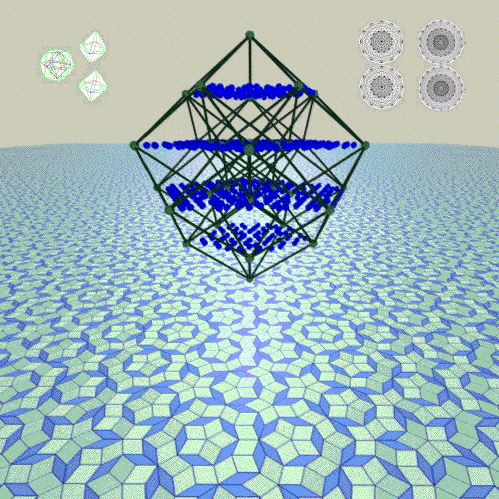
The 2-dimensional Penrose Tiling in the above image was generated by Quasitiler as a section of a 5-dimensional cubic lattice based on the 5-dimensional HyperCube shown in the center above the Penrose Tiling plane.
The above-plane geometric structures in the above image are, going from left to right:
- 4-dimensional 24-cell, whose 24 vertices are the root vectors of the 24+4 = 28-dimensional D4 Lie algebra;
- two 4-dimensional HyperOctahedra, lying (in a 5th dimension) above and below the 24-cell, whose 8+8 = 16 vertices add to the 24 D4 root vectors to make up the 40 root vectors of the 40+5 = 45-dimensional D5 Lie algebra;
- 5-dimensional HyperCube, half of whose 32 vertices are lying (in a 6th dimension) above and half below the 40 D5 root vectors, whose 16+16 = 32 vertices add to the 40 D5 root vectors to make up the 72 root vectors of the 72+6 = 78-dimensional E6 Lie algebra;
- two 27-dimensional 6-dimensional figures, lying (in a 7th dimension) above and below the the 72 E6 root vectors, whose 27+27 = 54 vertices add to the 72 E6 root vectors to make up the 126 root vectors of the 126+7 = 133-dimensional E7 Lie algebra; and
- two 56-dimensional 7-dimensional figures, lying (in an 8th dimension) above and below the the 126 E7 root vectors, and two polar points also lying above and below the 126 E7 root vectors, whose56+56+1+1 = 114 vertices add to the 126 E7 root vectors to make up the 240 root vectors of the 240+8 = 248-dimensional E8 Lie algebra.
- Cl(1,7) has 256 = 2^8 elements, corresponding to the 2^8 vertices of an 8-dimensional HyperCube and having the graded structure
with even part 1 28 70 28 1 and odd part 8 56 56 8
- An 8-dimensional HyperCube decomposes into 2 half-HyperCubes, each with 128 vertices, and each corresponding to one of the 2 mirror-image half-spinor representations of the D8 Lie algebra whose Euclidean-signature spin group is 120-dimensional Spin(16) and whose half-spinor representations have dimension (1/2)(2^(16/2)) = 256/2 = 128;
- One half-HyperCube corresponds to the 128 even elements 1 28 70 28 1 and the other to the 128 odd elements 8 56 56 8;
- The128 vertices of the odd 8-dimensional half-HyperCube
with graded structure 8 56 56 8 correspond to 128 of the 240 E8 root vectors as follows:
- 8 to the 8 octonion vector space basis elements, with positive sign;
- 8 to the 8 octonion vector space basis elements, with negative sign;
- 56+56 = 112 to the 112 vectors with non-zero components on the octonion real axis;
- The other 240-128 = 112 do not directly correspond to the 128 vertices of the even 8-dimensional HyperCube of the even half-spinor representation of the D8 Spin(16) Lie algebra, but correspond to 112 of the 120 generators of Spin(16), the adjoint bivector representation of D8.
Here is another way to see the 240 E8 root vectors: Recall that the dual polytope to the 600-vertex 120-cell (4-dim hyper-dodecahedron)
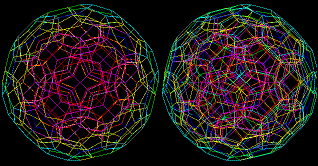
is the 120-vertex 600-cell (4-dim hyper-icosahedron)
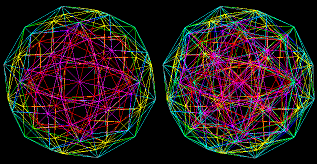
which can be made from vertices and Golden Ratio points on the edges of a 4-dim 24-cell
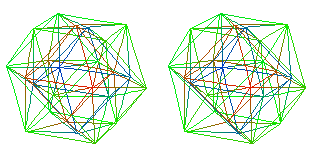
and
that
if the rational points of the 4-dim space
are taken to be a 4-dim subspace spanned by {1,i,j,k} in
the 8-dim octonion space with basis {1,i,j,k,E,I,J,K}
and the irrational Golden Ratio PHI = ((1 + sqrt(5)) / 2) points
are taken to be a 4-dim subspace spanned by {E,I,J,K}
then
the 120 vertices of the 600-cell generate
an E8 lattice in the 8-dim octonionic space.
To see what some structures related to the 120-cell and 600-cell,
and many other interesting things, look like, see
a Kyoto WWW page
Professor Koji Miyazaki at Kyoto has done much work on
golden isozonahedra and related geometric structures.
Consider the 6-dim subspace spanned by {i,j,k,I,J,K}.
The 3-dim {i,j,k} subspace is the spatial part of
the 4-dim rational {1,i,j,k} quaternionic spacetime.
It is the associative 4-dim spacetime of the
D4-D5-E6 model.
The 3-dim {I,J,K} subspace is the spatial part of
the 4-dim irrational Golden {E,I,J,K} quaternionic spacetime.
It is the coassociative 4-dim internal symmetry space of the
D4-D5-E6 model.
The 6-dim {i,j,k,I,J,K} space has 3-dim subspaces
that can correspond to our 3-dim physical space,
and we can look at the section of a 6-dim hypercubic lattice
that is in such 3-dim subspaces.
One such subspace is the 3-dim space {i,j,k},
for which the 3-dim section of the 6-dim hypercubic lattice
is a 3-dim cubic lattice.
Another such 3-dim subspace gives
a 3-dim face-centered-cubic fcc lattice.
Still another 3-dim subspace gives
for each 6-dim hypercube
a rhombic triacontahedron
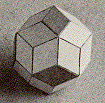
whose 30 rhombic faces each have Golden diagonal ratio PHI:1 A rhombic triacontahedron is the dual of the icosidodecahedron and can be made by truncating the 30 edges of an icosahedron. Therefore a rhombic triacontahedron is intermediate between a cube of a cubic lattice and a truncated octahedron associated with part of an fcc lattice just as an icosahedron is intermediate between an octahedron and a cuboctahedron with respect to Fuller jitterbug or tensegrity transformations. Lalvani at NYIT (see Connections, by Kappraff) has shown
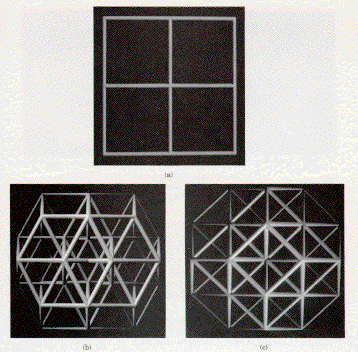
a continuous transformation based on 3-dim sections of a 6-dim hypercube from cube to rhombic triacontahedron to truncated octahedron. Although rhombic triacontahedra do not fill space, just as truncated icosahedra do not fill space, 3-dim space can be filled by left-handed and right-handed fists with Golden rhombus faces:
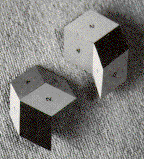
The tiling of 3-dim space by left and right fists
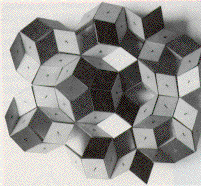
projects onto 2-dim space to produce an aperiodic Penrose tiling. The program QuasiTiler produces Penrose tilings by taking 2-dim slices of a 5-dim hypercubic lattice, rather than the 2-step process of 6-dim to 3-dim to 2-dim described above, but the results are the same. Penrose tilings are made up of kites and darts:
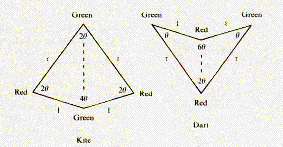
Question: There are 7 different kinds of vertex neighborhoods of Penrose tilings by kites and darts.
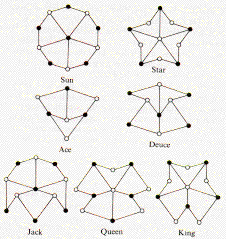
Are they related to the 7 imaginary octonions? In their book, Tilings and Patterns, Grunbaum and Shephard show that a tiling by Penrose kites and darts can be cut up into 8 types of tiles:
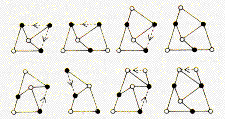
These 8 types of tiles have 28 different kinds of edges:
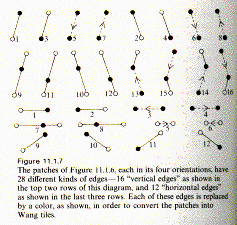
There are 16 vertical edges and 12 horizontal edges. Questions: Do the 8 types of tiles correspond to the 8-dim vector and half-spinor representations of Spin(0,8)? Do the 28 edges correspond to the 28-dim adjoint representation of Spin(0,8)? Do the 16 vertical edges correspond to the 16-dim U(4) = Spin(0,6) x U(1) that gives conformal gravity by the MacDowell-Mansouri mechanism in the D4-D5-E6-E7 model? Do the 12 horizontal edges correspond to the 12-dim Standard Model SU(3)xSU(2)xU(1) of the D4-D5-E6-E7 model? The 8 types of tiles, when reflected horizontally and vertically, produce a set of 32 aperiodic Wang tiles:
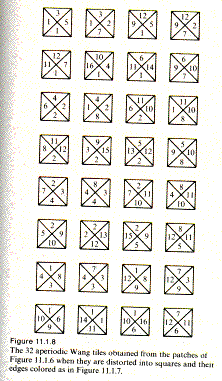
This set of 32 aperiodic Wang tiles is a subset of the set of 4x16 = 64 square tiles each of whose 4 sides has one of 16 colors. It can also be considered to be a subset of the 64 hexagrams of the I Ching. UNIVERSAL TRANSFORMATIONS are interpreted by the I CHING.
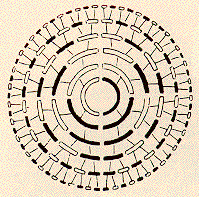
The 4x4x4 = 64 genetic code, the 2x2x2x2x2x2 = 64 I Ching, and the 8x8 = 64 D4-D5-E6 physics model are all just different representations of the same fundamental structure. This fundamental structure is not only shared by Golay codes and Leech lattice but also by Penrose tilings and musical sequences. The I Ching is used as a book of changes, or transformations, and as such can be thought of as a universal computer. Since the Tiling Problem is undecidable, if the set of 64 hexagrams is identified with the aperiodic set of 64 Wang tiles, they can simulate the operation of any Turing machine, and therefore process information, so that the traditional role of the I Ching hexagrams is confirmed by the mathematics of Penrose-Wang tilings.
An interesting aperiodic set of Wang tiles has 16 tiles:
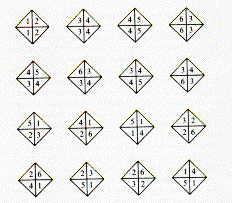
Karel Culik
II
has presented An
Aperiodic Set of 13 Wang Tiles over 5 colors.
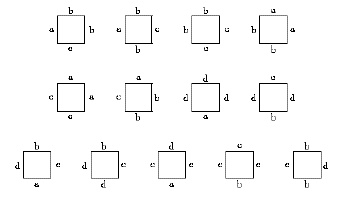
Its construction is based on a technique developed by Jarrko Kari, who constructed an aperiodic set consisting of 14 tiles over 6 colors. The tilings simulate behavior of sequential machines that multiply real numbers in balanced representations by real constants.
Penrose tilings can produce musical sequences. According to 10.6.9 of Grunbaum and Shephard, Any musical sequence can be defined by differencing the sequence [ PHI n + c ] as n runs through the integers, and then substituting S and L for 1 and 2 respectively. Here c is any real number; without loss of generality, c can be chosen to be in the interval [0,1]. This example shows the middle-C sequence:
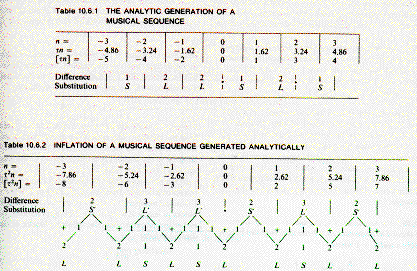
Question:
Can musical sequences also simulate the operation of
any
Turing machine?
References for this section include: 3D Filmstrip - used for red-green 3D polyhedra images Coxeter - Complex Regular Polytopes, 2nd ed - Cambridge 1991; Fuller - Synergetics - Macmillan 1975; Grunbaum and Shephard - Tilings and Patterns - Freeman 1987; Holden - Shapes, Space, and Symmetry - Dover 1971; Kappraff - Connections - McGraw-Hill 1991; Senechal - Quasicrystals and Geometry - Cambridge 1995; and
Quasitiler - The Penrose Tiling and 5-dim HyperCube in the image at the top of this page is from a web page of Alex Feingold. Unfortunately, the link to Quasitiler at the Geometry Center of the University of Minnesota is no longer good, because not only was the URL http://freeabel.geom.umn.edu/ changed to http://www.geom.umn.edu/ some time ago, but now the Geometry Center has gone away (NSF funds were cut off). Some of its pages live on in google cache, such as http://www.google.com/search?q=cache:s_WVB9Mv-4MC:www.geom.umn.edu/closed.html+&hl=en , but I don't know how to access all of them, and I feel that the loss of the Geometry Center is a loss to all of us who use the web.
Other components of the image at the top of this page are from sources mentioned on some of my other web pages, such as 24anime and Weyl.
Chris Hillman has excellent web pages about Symbolic Dynamics and about Tiling Dynamical Systems.
Tony Smith's Home Page ......